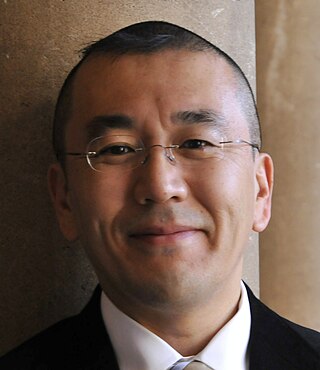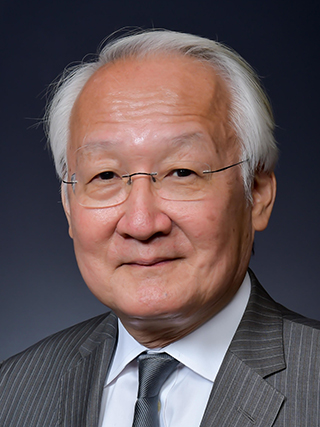
Issei Yamamoto was a Japanese astronomer and professor at Kyoto University. In 1920 he became first president of the Oriental Astronomical Association. He was director of the Kwasan Observatory in Kyoto.

Osaka University, abbreviated as Handai (阪大), is a public research university located in Osaka Prefecture, Japan. It is one of Japan's former Imperial Universities, a Designated National University and listed as a "Top Type" university in the Top Global University Project. The university is often ranked among the top three public universities in Japan, along with the University of Tokyo and Kyoto University.
HD 74272 is a star in the constellation Vela. It has the Bayer designation n Velorum, while HD 74272 is the identifier from the Henry Draper catalogue. This is a white hued star that is faintly visible to the naked eye with an apparent visual magnitude of 4.74. It is located at a distance of approximately 1,800 light years from the Sun based on parallax. The star is drifting further away with a radial velocity of +17 km/s.

Toshihide Maskawa was a Japanese theoretical physicist known for his work on CP-violation who was awarded one quarter of the 2008 Nobel Prize in Physics "for the discovery of the origin of the broken symmetry which predicts the existence of at least three families of quarks in nature."

1619 Ueta, provisional designation 1953 TA, is a stony asteroid from the inner regions of the asteroid belt, approximately 11 kilometers in diameter. It was discovered on 11 October 1953, by Japanese astronomer Tetsuyasu Mitani at Kyoto University's Kwasan Observatory, near Kyoto, Japan. It was named after the former director of the discovering observatory.
HD 213429 is a spectroscopic binary system in the equatorial constellation of Aquarius. It has a combined apparent magnitude of 6.16 and is located around 83 light years away. The pair orbit each other with a period of 631 days, at an average separation of 1.74 AU and an eccentricity of 0.38.
HD 35984 is star in the northern constellation Auriga. It has an apparent magnitude of 6.20, which, according to the Bortle scale, indicates it is faintly visible to the naked eye from dark rural skies. Parallax measurements by the Hipparcos satellite indicates it lies at a distance of roughly 290 light years away.
HD 126141 is a suspected variable star in the northern constellation of Boötes.

Hirosi Ooguri is a theoretical physicist working on quantum field theory, quantum gravity, superstring theory, and their interfaces with mathematics. He is Fred Kavli Professor of Theoretical Physics and Mathematics and the Founding Director of the Walter Burke Institute for Theoretical Physics at California Institute of Technology. He is also the director of the Kavli Institute for the Physics and Mathematics at the University of Tokyo and is the chair of the board of trustees of the Aspen Center for Physics in Colorado.
Delta2 Telescopii is a blue-white-hued binary star system in the southern constellation of Telescopium. It is faintly visible to the naked eye, having an apparent visual magnitude of 5.05. The distance to this system, as determined with an annual parallax shift of 2.73 mas, is roughly 1,200 light-years. At that distance, the visual magnitude of the star is diminished by an extinction of 0.36 due to interstellar dust. The pair have an orbital period of 21.7 days and an eccentricity of 0.22. For the merged stellar classification, Houk (1978) gives B3 IV/V, while Levato (1975) lists a more evolved class of B3 III. It appears to be a relatively young system, barely 40 million years old.
Ococias Kyoto AC is a Japanese professional football club based in Kyoto, Kyoto Prefecture, that competes in Kansai Soccer League, as part of Japanese Regional Leagues.
Tau2 Lupi, Latinized from τ2 Lup, is a binary star system in the constellation Lupus. It is visible to the naked eye with a combined apparent visual magnitude of 4.34. Based upon an annual parallax shift of 10.22 mas as seen from Earth, it is located around 319 light years from the Sun. The two components orbit each other with a period of 26.2 years and a high eccentricity of 0.94. The brighter component is a magnitude 4.93 subgiant star with a stellar classification of F4 IV. Its companion is an A-type star with visual magnitude 5.55 and class A7:.

Kazutoshi Mori is a Japanese molecular biologist known for research on unfolded protein response. He is a professor of Biophysics at the Graduate School of Science, Kyoto University, and shared the 2014 Albert Lasker Basic Medical Research Award with Peter Walter for discoveries concerning the unfolded protein response — an intracellular quality control system that detects harmful misfolded proteins in the endoplasmic reticulum and signals the nucleus to carry out corrective measures.

Tasuku Honjo is a Japanese physician-scientist and immunologist. He won the 2018 Nobel Prize in Physiology or Medicine and is best known for his identification of programmed cell death protein 1 (PD-1). He is also known for his molecular identification of cytokines: IL-4 and IL-5, as well as the discovery of activation-induced cytidine deaminase (AID) that is essential for class switch recombination and somatic hypermutation.

The Kansai Collegiate American Football League (関西学生アメリカンフットボール連盟) is an American college football league made up of fifty-three colleges and universities in the Kansai region of Japan.
Akeno Observatory is a cosmic ray observatory located in Akeno, a town in Yamanashi prefecture, Japan. The observatory is run by the Institute for Cosmic Ray Research (ICRR), based at the University of Tokyo. Akeno Observatory features AGASA, the Akeno Giant Air Shower Array, which studies the origins of very high energy cosmic rays.

Makoto Yano is a Japanese economist, currently the president and chief research officer of the Research Institute of Economy, Trade and Industry. He is also a professor emeritus at Kyoto University and a professor by special appointment at Kyoto University's Institute of Economic Research and Sophia University.

Graduate School of Science and Faculty of Science (京都大学大学院理学研究科・理学部) is one of schools at the Kyoto University. The Faculty and the graduate School operate as one.

Graduate School of Engineering and Faculty of Engineering (京都大学大学院工学研究科・工学部) is one of schools at the Kyoto University. The Faculty (Undergraduate) and the Graduate School operate as one.

Graduate School of Medicine and Faculty of Medicine (京都大学大学院医学研究科・医学部) is one of the schools at the Kyoto University. The Faculty and the Graduate School operate as one.













